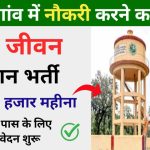All State Bhulekh: The Bhulekh system in India is a digital platform that provides citizens with easy access to land records. This initiative aims to enhance transparency and reduce disputes related to land ownership by digitizing land records across various states.
With the increasing importance of land records in property transactions, inheritance, and legal matters, understanding how to access these records is crucial for farmers, landowners, and potential buyers. This article will guide you through the Bhulekh system, its significance, and how to check land records across different states in India.
What is All State Bhulekh?
Bhulekh refers to the digital land record management system implemented by state governments in India. It serves as an online repository of land-related information, including ownership details, property boundaries, survey numbers, and other vital data. The primary objectives of Bhulekh include:
- Transparency: Providing clear access to land records helps reduce fraudulent transactions and disputes.
- Accessibility: Citizens can conveniently access their land records from anywhere without visiting government offices.
- Efficiency: Digital records streamline the process of verifying ownership and facilitate smoother property transactions.
Importance of Bhulekh
The Bhulekh system plays a pivotal role in various aspects of land management:
- Establishing Ownership: Bhulekh serves as a primary source for verifying land ownership and legal rights.
- Facilitating Transactions: It simplifies the process of buying, selling, or mortgaging property by providing authentic documentation.
- Dispute Resolution: In cases of land disputes, Bhulekh records act as reliable evidence to establish rightful ownership.
- Revenue Collection: The system assists governments in assessing property taxes based on accurate land records.
How to Access Bhulekh Records
Each state in India has its own Bhulekh portal managed by the respective revenue department. The general steps to access land records on these portals are as follows:
- Visit the Official State Bhulekh Website: Search for your state’s specific Bhulekh portal (e.g., “Bhulekh [State Name]”).
- Select District and Tehsil: Choose your district and tehsil or taluka from the dropdown menus provided.
- Enter Relevant Details: Input necessary information such as the owner’s name, survey number, or property address.
- Access Land Records: View and download the required land records.
State-wise Bhulekh Portals
Here’s a comprehensive list of Bhulekh portals for various states along with their unique features:
1. Uttar Pradesh (UP)
- Portal: UP Bhulekh
- Key Features:
- View Khatauni (Record of Rights)
- Check land maps
- Search by Khasra number or owner’s name
- How to Check Records:
- Select district, tehsil, and village.
- Choose search criteria (Khasra number, account number, etc.).
- Access and download the record.
2. Rajasthan
- Portal: Rajasthan Bhulekh
- Key Features:
- Comprehensive land record details
- Mutation status
- Interactive maps
- How to Check Records:
- Select district and tehsil.
- Enter details like Khasra number or owner’s name.
- View and print the land record.
3. Maharashtra
- Portal: Maharashtra Bhulekh
- Key Features:
- Access to 7/12 extract (land ownership document)
- Mutation details
- How to Check Records:
- Select district and taluka.
- Enter survey number or owner’s name.
- Download the relevant documents.
4. Gujarat
- Portal: Gujarat Bhulekh
- Key Features:
- Land record search by owner name or survey number
- Property maps available
- How to Check Records:
- Choose district and taluka.
- Enter required information.
- Access and download the record.
5. Haryana
- Portal: Haryana Bhulekh
- Key Features:
- View Jamabandi (land revenue record)
- Check mutation status
- How to Check Records:
- Select district and village.
- Enter details like Khasra number or owner’s name.
- View the record online.
6. Punjab
- Portal: Punjab Bhulekh
- Key Features:
- Access Jamabandi details
- Land ownership verification
- How to Check Records:
- Select district and village.
- Enter relevant search criteria.
- Download the required documents.
7. Odisha
- Portal: Bhulekh Odisha
- Key Features:
- ROR (Record of Rights) view
- Land maps available for viewing
- How to Check Records:
- Select district and tehsil.
- Choose plot details or map view options.
8. Bihar
- Portal: Bihar Bhulekh
- Key Features:
- Access Khasra and Khatauni details
- How to Check Records:
- Select district and block.
- Enter necessary information to view records.
9. Jharkhand
- Portal: Jharkhand Bhulekh
- Key Features:
- Land record access based on Khesra number or account number
- How to Check Records:
- Select district and enter relevant details for searching.
Additional States
Most Indian states have established their own portals under the Digital India Land Record Modernization Program (DILRMP). Here are some more examples:
| State | Portal Link | Key Features |
|---|---|---|
| Chhattisgarh | Chhattisgarh Bhulekh | Land record search via Khasra number |
| Himachal Pradesh | Himachal Pradesh Bhulekh | Jamabandi copy access |
| Telangana | Telangana Bhulekh | Land records with survey numbers |
| West Bengal | West Bengal Bhulekh | Online access to Khatiyan |
Benefits of Using Bhulekh System
The digitization of land records through the Bhulekh system offers numerous advantages:
- Ease of Access: Citizens can check their land records from home without needing physical visits to government offices.
- Time-Saving Process: The online system significantly reduces time spent on obtaining land-related information.
- Reduced Corruption Opportunities: By providing direct access to records, it minimizes chances for corruption or manipulation by intermediaries.
- Improved Transparency: The availability of public records enhances accountability among officials managing land-related services.
Challenges Faced by Users
Despite its advantages, users may encounter certain challenges when using the Bhulekh system:
- Technical Issues: Users may face downtime or glitches on state portals due to high traffic or maintenance activities.
- Complex Navigation: Some portals may not have user-friendly interfaces, making it difficult for less tech-savvy individuals to navigate effectively.
- Incomplete Data Updates: In some states, data may not be updated regularly, leading to discrepancies in ownership information.
Conclusion
The introduction of the Bhulekh system has revolutionized how citizens access land records in India. By providing a centralized digital platform for checking ownership details, property boundaries, and other essential information related to land parcels, it has significantly enhanced transparency and efficiency in property transactions.
As more states continue to improve their portals and ensure regular updates of data, citizens can expect an even smoother experience when accessing their land records online. Understanding how to navigate these systems will empower individuals—whether they are farmers looking for verification of their holdings or prospective buyers seeking clarity on property ownership—to make informed decisions regarding their real estate transactions.
By leveraging technology through platforms like Bhulekh, India is taking significant strides towards modernizing its land management systems while ensuring that citizens have reliable access to critical information regarding one of their most valuable assets—their land.








